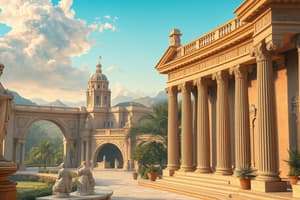Podcast
Questions and Answers
What were the main forms of Greek art?
What were the main forms of Greek art?
- Sculpture, painting, mosaic, jewelry making (correct)
- Architecture, pottery, weaving, metalwork
- Painting, sculpture, embroidery, glass making
- Sculpture, pottery, architecture, calligraphy
Which civilization is credited with giving birth to Western classical art?
Which civilization is credited with giving birth to Western classical art?
- Cycladic civilization
- Minoan civilization
- Roman civilization
- Greek civilization (correct)
Which artwork is mentioned in the text as a lost massive chryselephantine sculpture made by Phidias?
Which artwork is mentioned in the text as a lost massive chryselephantine sculpture made by Phidias?
- Athena Parthenos (correct)
- Statue of Zeus at Olympia
- Luxury objects in metal-work
- The Stag Hunt Mosaic
What are considered minor forms of Roman art in modern terms?
What are considered minor forms of Roman art in modern terms?
During which era did Greek art absorb influences from Eastern civilizations and Roman art?
During which era did Greek art absorb influences from Eastern civilizations and Roman art?
What significant Western historical event invigorated Greek art with Italian and European ideas according to the text?
What significant Western historical event invigorated Greek art with Italian and European ideas according to the text?
What distinguishes the anthropomorphic pottery jars in the text?
What distinguishes the anthropomorphic pottery jars in the text?
When did statues in Greek art start to depict real people?
When did statues in Greek art start to depict real people?
What is a characteristic of sculpture during the Classical period of Greek art?
What is a characteristic of sculpture during the Classical period of Greek art?
What marked a revolution in Greek statuary during the Classical period?
What marked a revolution in Greek statuary during the Classical period?
Which sets of statues were said to be the first public monuments to actual people in Athens?
Which sets of statues were said to be the first public monuments to actual people in Athens?
What is a key characteristic of classical art associated with Greece and Rome?
What is a key characteristic of classical art associated with Greece and Rome?
What is true about the survival rates of sculpture and figure painting from ancient Rome?
What is true about the survival rates of sculpture and figure painting from ancient Rome?
Which Roman structure in Segovia, Spain is a well-preserved elevated aqueduct bridge?
Which Roman structure in Segovia, Spain is a well-preserved elevated aqueduct bridge?
Which Roman structure is considered the largest amphitheatre ever built?
Which Roman structure is considered the largest amphitheatre ever built?
When did the Middle Ages (Medieval period) in Europe begin and end?
When did the Middle Ages (Medieval period) in Europe begin and end?
Which Roman structure is a symbol of Segovia and appears on the city's coat of arms?
Which Roman structure is a symbol of Segovia and appears on the city's coat of arms?
What characterized Romans' opinion on sculpture and figure painting in ancient times?
What characterized Romans' opinion on sculpture and figure painting in ancient times?
Flashcards are hidden until you start studying
Study Notes
Classical Period
- The most famous works of the Classical period include the colossal Statue of Zeus at Olympia and Athena Parthenos, a massive chryselephantine sculpture of the Greek goddess Athena.
- Athena Parthenos was made by Phidias and his assistants and housed in the Parthenon in Athens.
Greek Art
- Greek art began in the Cycladic and Minoan civilization and gave birth to Western classical art.
- It absorbed influences from Eastern civilizations, Roman art, Orthodox Christianity, and Italian and European ideas during the Romanticism period.
- Greek art has five main forms: architecture, sculpture, painting, pottery, and jewelry making.
Roman Art
- Roman art refers to the visual arts made in Ancient Rome and its territories.
- It includes architecture, painting, sculpture, and mosaic work, as well as luxury objects like metalwork, gem engraving, ivory carvings, and glass.
Roman Sculpture
- During the Classical period, there was a revolution in Greek statuary, associated with the introduction of democracy and the end of the aristocratic culture.
- Poses became more naturalistic, and Greek sculptors' technical skill in depicting the human form increased greatly.
- From around 500 BC, statues began to depict real people, like the statues of Harmodius and Aristogeiton in Athens.
Roman Architecture
- The Aqueduct of Segovia in Spain is one of the best-preserved elevated Roman aqueducts.
- The Colosseum, also known as the Flavian Amphitheatre, is an oval amphitheatre in the centre of Rome, Italy, built of travertine, tuff, and brickfaced concrete.
Medieval Period
- The Middle Ages lasted from the 5th to the 15th century, beginning with the fall of the Western Roman Empire and merging into the Renaissance and the Age of Discovery.
- It is the middle period of the three traditional divisions of Western history: classical antiquity, the medieval period, and the modern period.
Studying That Suits You
Use AI to generate personalized quizzes and flashcards to suit your learning preferences.




